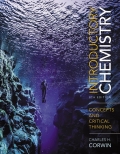
Concept explainers
(a)
Interpretation:
The physical state for the given element at
Concept introduction:
The elements in the modern periodic table are arranged in an increasing order of their
(b)
Interpretation:
The physical state for the given element at
Concept introduction:
The elements in the modern periodic table are arranged in an increasing order of their atomic number. The horizontal rows in the periodic table are known as periods and the vertical columns are said to be groups. There are
(c)
Interpretation:
The physical state for the given element at
Concept introduction:
The elements in the modern periodic table are arranged in an increasing order of their atomic number. The horizontal rows in the periodic table are known as periods and the vertical columns are said to be groups. There are
(d)
Interpretation:
The physical state for the given element at
Concept introduction:
The elements in the modern periodic table are arranged in an increasing order of their atomic number. The horizontal rows in the periodic table are known as periods and the vertical columns are said to be groups. There are
Want to see the full answer?
Check out a sample textbook solution
Chapter 3 Solutions
EBK INTRODUCTORY CHEMISTRY
- Write chemical equations for each of the following chemical and physical processes: (a) Reaction of ammonia gas with hydrogen chloride gas to produce a solid product (b) Reaction of 1 mole of aluminum with I2(s) to form aluminum iodide (c) Conversion of 1 mole of O2(g) to O3(g) (d) Dissolving K2Cr2O7(s) in water (e)Thermal decomposition of solid sodium azide to produce solid sodium and nitrogen gas (f) Photodissociation of chlorine gas (g) Fusion of icearrow_forward(a) Hydrogen chloride gas reacts with oxygen gas to produce chlorine gas and water vapor.n (6) Solid diarsenic trioxide reacts with fluorine gas to produce liquid arsenic pentafluoride and oxygen gas. (c) Gaseous sulfur tetrafluoride reacts with liquid water to produce gaseous sulfur dioxide and hydrogen fluoride gas. (d) Solid molybdenum(VI) oxide reacts with gaseous xenon difluoride to form liquid molybdenum(VI) fluoride, xenon gas, oxygen gas. and aterarrow_forwardWrite Q꜀ for each of the following:(a) Hydrogen chloride gas reacts with oxygen gas to producechlorine gas and water vapor.(b) Solid diarsenic trioxide reacts with fluorine gas to produceliquid arsenic pentafluoride and oxygen gas.(c) Gaseous sulfur tetrafluoride reacts with liquid water to pro-duce gaseous sulfur dioxide and hydrogen fluoride gas.(d) Solid molybdenum(VI) oxide reacts with gaseous xenon di-fluoride to form liquid molybdenum(VI) fluoride, xenon gas, andoxygen gas.arrow_forward
- is formed from... Br NH2 N-H (A) (B) (C) (D) (E) O Compounds B and E Compounds A and E Compounds C and D Compounds A and Darrow_forward(k) Antimony (V) iodide (1) Gold (III) sulfide (m) Platinum (IV) phosphide (n) Bismuth (II) perchlorate (0) Mercury (I) cyanidearrow_forwardWhat are the chemical properties of Lead and its occurance in naturearrow_forward
- (a) Write the chemical equation for the formation of 1 mole of ethanol from its elements. Include the states of matter.arrow_forward(a) Nitrogen and hydrogen react to give ammonia in a combination reaction. Write and balance the equation. (Use the lowest possible coefficients.) (b) Electrolysis can decompose KCl into its elements. Write and balance the equation. (Use the lowest possible coefficients.)arrow_forward4. a) b)arrow_forward
- What is a chemical property of sodium?arrow_forwardIodine monochloride and elemental bromine have nearly the same molar mass and liquid density but very different boiling points. (a) What molecular property is primarily responsible forthis difference in boiling point? What atomic property gives rise to it? Explain. (b) Which substance has a higher boiling point?Why?arrow_forwardMetal always found in free state is:(a) Gold(b) Silver(c) Copper(d) Sodiumarrow_forward
 Chemistry: Principles and ReactionsChemistryISBN:9781305079373Author:William L. Masterton, Cecile N. HurleyPublisher:Cengage Learning
Chemistry: Principles and ReactionsChemistryISBN:9781305079373Author:William L. Masterton, Cecile N. HurleyPublisher:Cengage Learning
